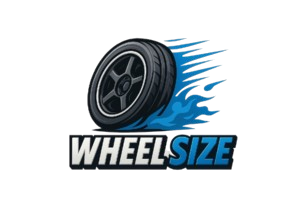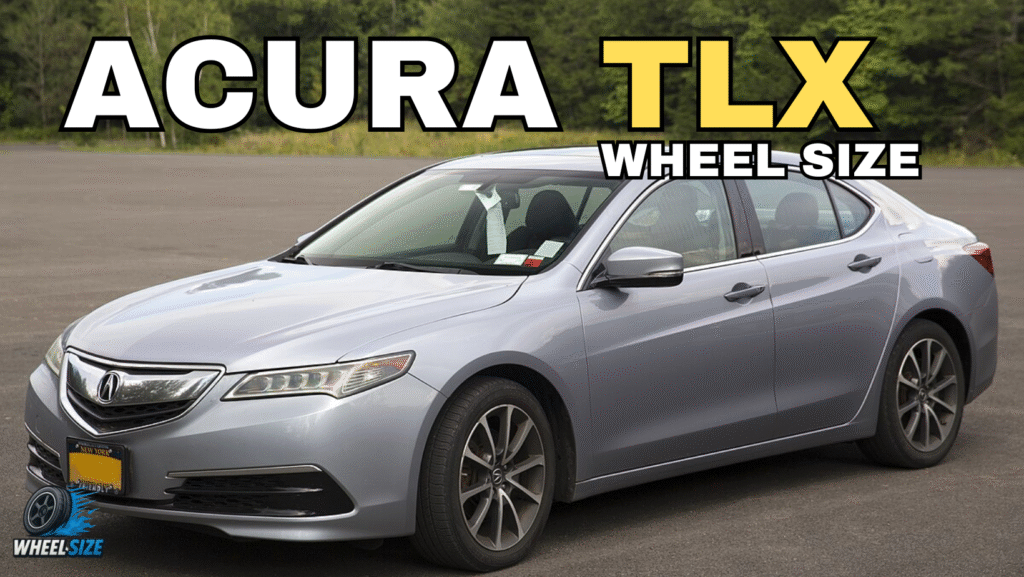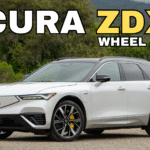Introduction
The Acura TLX has always been a popular choice for those who value luxury with a performance edge. Whether you’re upgrading to a new set of wheels or just curious about your sedan’s fitment specs, understanding the correct dimensions is essential. From the bolt pattern to the offset and tire size, every measurement affects handling, appearance, and overall driving safety.
This guide breaks down wheel fitment for all TLX generations—from 2014 to the newest models. You’ll get specs like bolt pattern, rim size, center bore, offset range, and OEM tire sizes year-by-year. Whether you’re customizing with aftermarket wheels or sticking to factory setups, we’ve got the info you need to avoid costly mistakes.
Let’s dive into each TLX generation and see what fits best, what’s changed over time, and what your options are when it comes to giving your Acura TLX the stance and performance it deserves.
Read About: Acura RDX Wheel Fitment
Acura TLX II (UB5-7) [2021–2026] Wheel Fitment Specifications
The second-generation Acura TLX brought a bold redesign and new performance DNA. Along with that came notable changes in wheel specs. Unlike the first-gen TLX, this generation uses a 5×120 bolt pattern—a change from the previous 5×114.3. That alone makes wheel swapping between generations tricky without adapters.
Factory wheel sizes range from 18 to 20 inches, offering flexibility for drivers seeking style or sport. The center bore holds at 64.1 mm, while the offset range is fairly narrow between 48–52 mm, which ensures the wheels sit flush without rubbing or clearance issues. OEM tire sizes vary from 235/50R18 to 255/35ZR20, depending on trim and year.
Torque has increased to 127 Nm due to the larger lug size—M14 x 1.5. When considering aftermarket wheels, make sure to maintain proper tire pressure (2.2 bar front and rear for most models) to preserve ride quality.
TLX II (2021–2026) Wheel Specs Table
| Year | Bolt Pattern | Center Bore | Lug Thread | Torque (Nm) | OEM Tire Size | OEM Rim Size | Offset Range | Tire Pressure | Aftermarket Range |
| 2021 | 5×120 | 64.1 mm | M14 x 1.5 | 127 | 235/50R18 | 8Jx18 ET50 | 48–52 mm | 2.2 / 2.1 bar | 18″–20″ |
| 2022 | 5×120 | 64.1 mm | M14 x 1.5 | 127 | 255/40ZR19 | 8.5Jx19 ET50 | 48–52 mm | 2.2 / 2.2 bar | 18″–20″ |
| 2023 | 5×120 | 64.1 mm | M14 x 1.5 | 127 | 255/35ZR20 | 9Jx20 ET50 | 48–52 mm | 2.2 / 2.2 bar | 18″–20″ |
| 2024 | 5×120 | 64.1 mm | M14 x 1.5 | 127 | 235/50R18–255/35ZR20 | 8Jx18–9Jx20 | 48–52 mm | 2.2 / 2.1–2.2 bar | 18″–20″ |
| 2025 | 5×120 | 64.1 mm | M14 x 1.5 | 127 | 235/50R18–255/35ZR20 | 8Jx18–9Jx20 | 48–52 mm | 2.2 / 2.1–2.2 bar | 18″–20″ |
| 2026 | 5×120 | 64.1 mm | M14 x 1.5 | 127 | 235/50R18–255/35ZR20 | 8Jx18–9Jx20 | 48–52 mm | 2.2 / 2.1–2.2 bar | 18″–20″ |
Acura TLX I (UB1-4) Facelift [2018–2020] Wheel Fitment Specifications
The facelifted version of the TLX I introduced small design updates but retained the original wheel architecture. These models continue using a 5×114.3 bolt pattern, which is more common and widely supported in the aftermarket scene. The center bore remains at 64.1 mm, and lug threads stay with M12 x 1.5, torqued at 108 Nm.
Wheel sizes grew gradually from 17 inches in 2018 to 19 inches in 2020, with wider tire profiles to match. Depending on the trim, you’ll find OEM tire sizes like 225/55R17, 225/50R18, and 245/40R19. The offset range is usually between 48–52 mm, though the 2020 models with 19-inch wheels can go up to ET55–57.
These years maintain a tire pressure of 2.2 bar across both axles, providing a balanced ride. This generation offers a good balance between comfort and room for customization with aftermarket wheel sizes ranging from 17″ to 19″.
TLX I Facelift (2018–2020) Wheel Specs Table
| Year | Bolt Pattern | Center Bore | Lug Thread | Torque (Nm) | OEM Tire Size | OEM Rim Size | Offset Range | Tire Pressure | Aftermarket Range |
| 2018 | 5×114.3 | 64.1 mm | M12 x 1.5 | 108 | 225/55R17 | 7.5Jx17 ET50 | 48–52 mm | 2.2 / 2.2 bar | 17″–19″ |
| 2019 | 5×114.3 | 64.1 mm | M12 x 1.5 | 108 | 225/50R18 | 7.5Jx18 ET50 | 48–52 mm | 2.2 / 2.2 bar | 17″–19″ |
| 2020 | 5×114.3 | 64.1 mm | M12 x 1.5 | 108 | 245/40R19 or 245/45ZR18 | 8Jx19 ET55 or 8Jx18 ET50 | 50–57 mm | 2.2–2.5 bar | 17″–19″ |
Acura TLX I (UB1-4) [2014–2017] Wheel Fitment Specifications
The first-generation TLX established Acura’s new identity after phasing out the TL and TSX. It features a 5×114.3 bolt pattern, 64.1 mm hub bore, and M12 x 1.5 lug nuts. These specs make it compatible with many aftermarket wheels, especially in the Japanese and domestic markets.
Across these years, OEM rim sizes range from 17 to 20 inches, and offsets mostly fall between ET48–52 mm, with 2017 being an exception (ET50 for 20-inch wheels). OEM tire sizes range from 225/55R17 to 245/35ZR20, depending on the trim. The torque spec is consistent at 108 Nm, and tire pressures range from 2.2 to 2.5 bar, based on wheel size.
This generation is popular for modding thanks to its straightforward specs and compatibility with a wide range of aftermarket setups. Whether you’re looking for performance or aesthetics, this TLX generation has room to play.
TLX I (2014–2017) Wheel Specs Table
| Year | Bolt Pattern | Center Bore | Lug Thread | Torque (Nm) | OEM Tire Size | OEM Rim Size | Offset Range | Tire Pressure | Aftermarket Range |
| 2014 | 5×114.3 | 64.1 mm | M12 x 1.5 | 108 | 245/45ZR18 | 7.5Jx18 ET50 | 48–52 mm | 2.3 / 2.3 bar | 17″–20″ |
| 2015 | 5×114.3 | 64.1 mm | M12 x 1.5 | 108 | 225/55R17 | 7.5Jx17 ET50 | — | 2.2 / 2.2 bar | 17″–20″ |
| 2016 | 5×114.3 | 64.1 mm | M12 x 1.5 | 108 | 245/40ZR19 | 8Jx19 ET50 | — | 2.3 / 2.3 bar | 17″–20″ |
| 2017 | 5×114.3 | 64.1 mm | M12 x 1.5 | 108 | 245/35ZR20 | 8.5Jx20 ET50 | — | 2.5 / 2.5 bar | 17″–20″ |
Acura TLX Bolt Pattern, Offset, and Fitment Comparison
Across both generations, the Acura TLX showcases an evolution in its bolt pattern and wheel setup. The first-generation TLX (2014–2020) consistently used a 5×114.3 bolt pattern, which is one of the most common patterns among Japanese and mid-size sedans. It offered excellent flexibility for wheel upgrades due to the wide aftermarket support.
Starting from 2021, Acura shifted to a 5×120 bolt pattern, aligning the TLX more with performance vehicles like the BMW 3 Series. This change means wheels from the first generation are not directly compatible with the newer models without adapters. Along with this, the lug nut thread changed from M12 x 1.5 to M14 x 1.5, and torque specs increased from 108 Nm to 127 Nm, showing a structural upgrade in design.
Offset ranges stayed relatively stable across all years (typically between 48–52 mm), helping maintain a centered and safe wheel position. While hub bore remains unchanged at 64.1 mm, it’s important to note that wheel compatibility depends heavily on matching both the bolt pattern and offset correctly.
Choosing the Right Aftermarket Wheels for Acura TLX
When upgrading to aftermarket wheels, it’s not just about size—it’s about getting the specs right to maintain safety and performance. For all Acura TLX models, you’ll need to choose wheels that match the bolt pattern, hub bore, and sit within the recommended offset range. A mismatch can lead to poor handling, rubbing issues, or even unsafe driving.
For the first-generation TLX, you’re working with a 5×114.3 bolt pattern and 17″ to 20″ wheel sizes. Stick to an offset close to ET50, and use hub-centric rings if your aftermarket wheels have a larger bore.
With the second-generation TLX, your options are slightly more limited due to the 5×120 bolt pattern, but you can still go from 18″ to 20″. Make sure to match the M14 x 1.5 lug spec, and avoid deep-dish wheels that push the offset outside the 48–52 mm range.
Choosing lightweight alloys can also improve braking and ride quality without compromising style.
Common Wheel Fitment Mistakes to Avoid
One of the most common fitment mistakes TLX owners make is ignoring the lug nut thread size. Using M12 lugs on a car that requires M14 (or vice versa) can be dangerous and damage the wheel hub. Always double-check the lug thread before installing aftermarket wheels.
Another issue is fitting wheels with an incorrect offset. A wheel with too low of an offset can poke out past the fender and cause rubbing during turns or over bumps. On the other hand, a high offset can interfere with suspension components.
You should also avoid assuming that all 5-lug wheels will fit just because the number of bolts matches. A 5×114.3 wheel will not fit a 5×120 hub without adapters.
Lastly, overlooking center bore size can lead to vibrations. Even if the bolt pattern is correct, a loose fit at the hub requires hub-centric rings to keep things snug and vibration-free.
Conclusion
The Acura TLX is a refined sedan with a sporty soul, and getting the right wheels is key to unlocking its full potential. Whether you own a first-gen TLX with its flexible 5×114.3 bolt pattern or the newer, performance-driven TLX II with 5×120, fitment specs matter.
Always verify your bolt pattern, lug nut thread, rim width, offset range, and center bore before buying wheels. Pairing the right tire size with the appropriate rim will not only improve handling but also preserve ride comfort and safety.
With this guide, you now have a complete roadmap to TLX wheel compatibility—across all years and trims. Use it to avoid common fitment mistakes, choose the best aftermarket options, and keep your Acura rolling smooth and stylish.
FAQs
1. Can I install 20-inch wheels on a 2015 Acura TLX?
Yes, the 2015 TLX supports aftermarket wheels up to 20 inches, as long as you stay within the correct offset range (around ET48–52) and match the bolt pattern (5×114.3).
2. What is the bolt pattern for the 2022 Acura TLX?
The 2022 Acura TLX uses a 5×120 bolt pattern, which is different from earlier models. Be sure to get wheels specifically designed for that pattern or use appropriate adapters.
3. Are TLX I and TLX II wheels interchangeable?
No, the wheels are not directly interchangeable. TLX I uses a 5×114.3 pattern with M12 lugs, while TLX II uses 5×120 with M14 lugs. Adapters would be required to swap between them.
4. What’s the ideal offset for aftermarket wheels on a 2023 TLX?
For the 2023 TLX, stick within the OEM offset range of ET48 to ET52. Straying too far can affect handling and cause clearance issues.
5. Does changing wheels affect TPMS or tire pressure?
Yes. If you don’t transfer the TPMS sensors or use compatible aftermarket sensors, you’ll get a dashboard warning. Also, always follow OEM tire pressure recommendations to ensure proper tire wear and safety.



